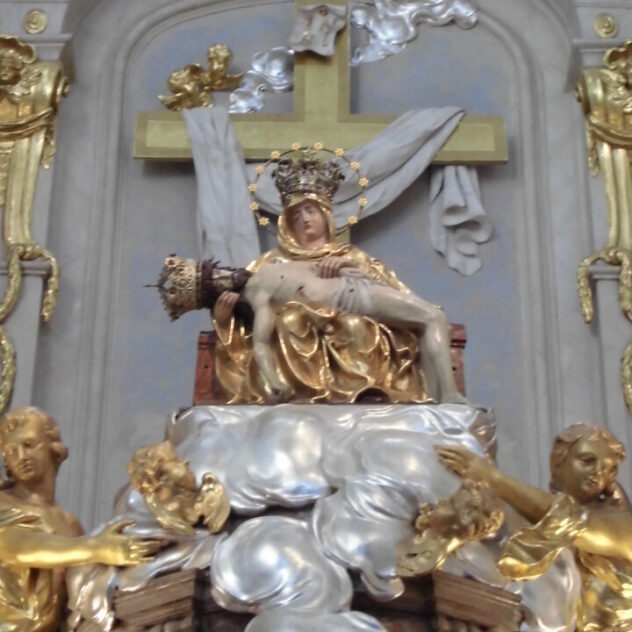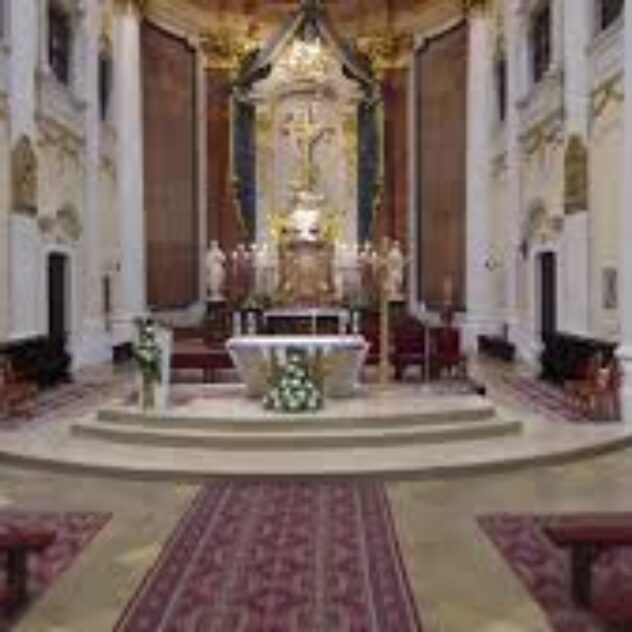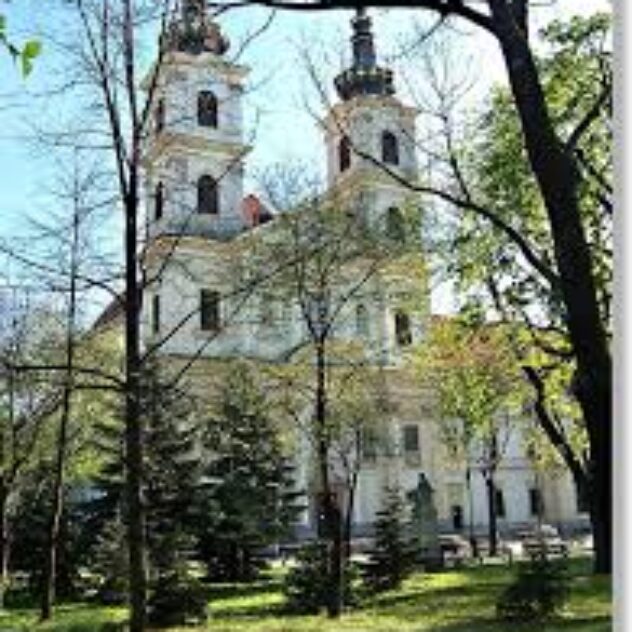Basilica of the Virgin Mary of the Seven Sorrows in Šaštín
Information about the pilgrimage site
The Pilgrimage Basilica of the Virgin Mary of the Seven Sorrows is located in the village of Šaštín – Stráže. The history of this area dates back to the arrival of the saints Cyril and Methodius in the 9th century. Since then, the veneration of the Virgin Mary of the Seven Sorrows has been alive in our territory. Many chapels and churches have been built and dedicated to this patron saint.
The beginnings of pilgrimage in Šaštín date back to 1564, when Angelika Bakičová, the wife of the owner of the Šaštín estate, had a statue of the Seven Sorrows made from pear wood. It was a token of gratitude for answering prayers for her husband. He lived a careless life and was also of a volatile nature. One day they were riding together in a carriage across the Zagorje plain and a disagreement arose between them. The husband could not control himself: he pushed his wife out of the carriage and drove on alone. Angelica knelt on the ground with tears in her eyes and prayed fervently for her husband’s conversion. Suddenly it seemed to her that Our Lady of the Seven Sorrows was standing before her with compassion on her face. The unhappy woman promised that if her husband would reform, she would have a statue of the Mother of God made from a nearby pear tree and a chapel built. Angelica felt a sudden calm and hurried home. A moment later she saw her husband’s carriage approaching. He got out and humbly asked her for forgiveness. He also agreed to the promise the wife had made to the Mother of God: to make and display a statue of her for public veneration. On this day, the first miracle took place – a human heart was healed. The faithful began to come to this place in increasing numbers and miraculous healings began to occur. It was then that Angelica fulfilled the second part of her promise: she had a chapel built where the statue was displayed and which became the destination of many processions of people from near and far.
Over time, the chapel ceased to meet the demands of visitors and so in 1736 construction work began on the present Basilica. It has undergone several reconstructions and renovations up to the present time. Over the years, it has been under the administration of the Pauline Order, the deanery of Šastina, the Salesians of Don Bosco, and now it is again under the administration of the Paulines. Among the important milestones is the year 1927, when the Holy Father Pius XI proclaimed the Virgin Mary of the Seven Sorrows as the patroness of Slovakia and the centre of her veneration naturally became Šaštín. On this occasion, a year later, the great national bell of the Seven Sorrows, weighing 4,745 kg, is consecrated. Even during the communist regime (when religious freedom was severely suppressed), Šaštín was visited. Even in the jubilee year of 1964 the church is elevated to a minor basilica by Pope Paul VI. Among the Basilica’s most distinguished pilgrims are St. Mother Teresa of Calcutta, St. John Paul II, and Pope Francis.
Currently, this pilgrimage site is one of the most visited in Slovakia (around 50,000 pilgrims come during the main pilgrimage). In addition to the main pilgrimage, there are also several organized pilgrimages during the year: e.g. pilgrimage of miniature pilgrims, motorcyclists, seniors, etc. However, believers (not only from Slovakia) also come in large numbers individually. The Marian Museum is also part of the complex, where visitors can learn about the history and present of this precious place.
Tourist attractions in the vicinity
Recreation area Gazárka – this recreation centre is built near the Basilica and is located in an environment of unique flora: unique pine forests, oak forests and marshes. It consists of five lakes, which were created after the sand was extracted. Today they are used for recreation and fishing. The lakes are surrounded by landscaped sandy beaches with gradual access to the water. The summer season is quite long, starting in May and ending in September. The surrounding forests are ideal for walking, cycling, picking mushrooms and berries. Accommodation options are very simple, reminiscent of the authentic atmosphere of those times when travel beyond the borders of the “communist bloc” was not allowed (http://www.gazarka.eu/site/).
Spa Smrdáky – the history of the spa dates back to 400 years ago. The spa is a jewel among the spas in Slovakia. They are popular and famous for their mineral water with a very high content of hydrogen sulphide, skin diseases are treated here. They are also referred to as the “Slovak Dead Sea”. Soldiers from all over the Austro-Hungarian Empire were treated here during the Napoleonic Wars and later the First World War.
Millennium Cross – it is a Slovak unique, as it is the highest cross in Slovakia. It has a height of up to 27 metres and the span of its arms is 9 metres. In the heart of the cross there is a symbol of the Jubilee year – a relief with five doves of different colours (symbolism of the 5 continents) and the inscription “Christ yesterday, today, forever”. The cross is located in a field near Šaštín, near the village of Rybky. It was erected in the Jubilee year 2000 – on the occasion of the 2000th anniversary of the birth of Jesus Christ. In the bowels of the cross there is a chapel of Divine Mercy with relics of St. Sister Faustina. Holy Mass is held here sporadically, especially at Easter time. Later, the area around the cross was supplemented by the Stations of the Cross. It is a popular place for its tranquillity and spiritual atmosphere.
Záhorská cyklomagistrála – the nature of the area where Šaštín is located (region Záhorie) has a relatively flat character and ideal conditions for cycling. A good network of cycle routes has been built and marked in the region. The routes run along existing state roads of lower classes and special-purpose roads, mostly with a paved surface. Due to the location of the region, the cycle routes are connected to the cycle routes of neighbouring countries. Four cycle routes form the basis of the cycle route network. For up-to-date cycle maps see e.g. www.mapy.cz.
Skalica – a picturesque town known for its unique triangular-shaped square. In addition, there are many interesting architectural monuments preserved and restored in the town. All known building styles can be traced here, including the oldest, which is the Romanesque style (the famous Rotunda of St. George). Skalica is also characterised by the Skalický trdelník (Skalický trdelník). It is a sweet bakery product which was the first to be awarded a protected geographical indication. Genuine trdelník has a nutty flavour and the recipe dates back to the 19th century. There are several shops in the town where it can be bought.
Accommodation
- Accommodation for pilgrims: the pilgrimage house, located directly in the pilgrimage area (https://bazilikamarianka.sk/putnicky-dom/)
- Other private accommodation around Šaštín
Availability
By car
Access by car is the fastest. The village of Šaštín is located near the D2 motorway (exit Kúty). There are several parking lots for cars and buses around the Basilica. The car parks are mostly free of charge.
By public transport
From Bratislava main train station it is possible to get to Šaštín by train with a change in the village of Kúty (the journey takes on average 80 min) or with a change in Trnava (the journey takes on average 120 min).
On foot
Walking pilgrimages usually take place before the Feast of the Virgin Mary of the Seven Sorrows (in Slovakia always on 15 September) from neighbouring and distant towns and villages: Trnava, Trstín, Topoľčany, Borský Mikuláš, Bratislava, etc. The Slovak Marian Way also leads to Šaštín from Gaboltov to Šaštín. This pilgrimage route is partly cycling (due to inadequate infrastructure) and partly walking (stages of the route: https://slovenska-marianska-cesta.webnode.sk/etapy-pute/severna-cesta/).
On a bicycle
Šaštín is very accessible by bike. The region of Záhorie, where Šaštín is located, has built a quality network of cycling routes, which are connected to the cycling routes of the surrounding countries. The routes run along existing state roads of lower classes and special-purpose roads, mostly with a paved surface. For the most up-to-date cycle maps see e.g. www.mapy.cz.







